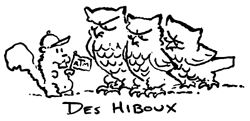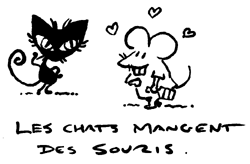Nouns
number: singular and plural
In French, a noun is always either singular or plural. It is usually introduced by a determiner, which reflects the number of the noun.
regular plural formation
As in English, the plural is formed by adding an –s to the singular form of the noun. Note, however, that the –s is not pronounced. In spoken language, the determiner is often the only indication that a noun is singular or plural.
| Tex est un tatou. Tex et Tammy sont des tatous. | Tex is an armadillo. Tex and Tammy are armadillos. |
nouns ending in -s, -x, -z in the singular
Nouns ending in -s, -x, or -z do not change in the plural. For example:
| Tex a un long nez. Les tatous ont toujours de longs nez. | Tex has a long nose. Armadillos always have long noses. | |
| Joe-Bob est un écureuil. Les écureuils adorent les noix. Joe-Bob mange au moins une noix par jour. | Joe-Bob is a squirrel. Squirrels adore nuts. Joe-Bob eats at least one nut every day. | |
| Bette est une chatte. Les chats mangent des souris. Est-ce que Bette a jamais mangé une souris? | Bette is a cat. Cats eat mice. Has Bette ever eaten a mouse? |
nouns ending in -al, -ail, -au, -eu, -eau, -ou in the singular
Nouns ending in –al, –ail, or –au in the singular end in –aux in the plural. For example:
| Edouard est un animal distingué. Corey et Fiona ne sont pas des animaux, ce sont des insectes peu sociables! | Edouard is a distinguished animal. Corey et Fiona are not animals. They are unsociable insects! |
There are a few exceptions: un bal (ball, dance), des bals; un carnaval (carnival), des carnavals; un festival (festival), des festivals; un récital (recital), des récitals.
Nouns ending in –eu or –eau in the singular add –x in the plural. For example:
| Edouard n’a pas un seul cheveu. Bien sûr, c’est un escargot! Mais Tammy a les cheveux longs. C’est une tatou extraordinaire! | Edouard does not have one single hair. Of course, he’s a snail. But Tammy has long hair. She’s an extraordinary armadillo! |
Nouns ending in –ou end in –oux in the plural:
- un bijou (jewel), des bijoux
- un caillou (stone, pebble), des cailloux
- un chou (cabbage), des choux
- un genou (knee), des genoux
- un hibou (owl), des hiboux
- un pou (louse), des poux
Exceptions include: un clou (nail), des clous; un sou (money), des sous; un trou (hole), des trous.

 irregular plurals
irregular plurals
Some nouns have an alternate form in the plural:
- un oeil (eye), des yeux
- Madame (Madam), Mesdames
- Monsieur (Sir), Messieurs
- Mademoiselle (Miss), Mesdemoiselles
Note that some nouns follow the regular rule of plural formation but are pronounced differently in the plural. For example, the -f is pronounced in the singular, but not in the plural. Listen:
- un oeuf (egg), des oeufs
- un boeuf (steer), des boeufs
- un os (bone), des os
Listen to the dialogue:
| Corey: Dis Bette, tu as déjà mangé une souris? | Corey: Bette, have you ever eaten a mouse? | |
| Bette: Oh oui! J’aime les souris! Et aussi les rats, les oiseaux, les lézards. Je ne mange jamais de végétaux, mais quelquefois des insectes … | Bette: Oh yes! I love mice! And rats, birds and lizards too! I never eat plants, but sometimes insects … | |
| Corey: Des insectes! Allez, au revoir. | Corey: Insects! Alright, bye-bye. |


